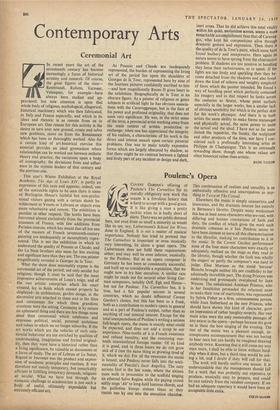Contemporary Arts
Ceremonial Art
IN recent years the art of the seventeenth century has become increasingly a focus of historical scrutiny and research. Of course, the great figures of the time- Rembrandt, Rubens, Vermeer, Velasquez, for example—have always been studied and ap- preciated; but now attention is upon that whole body of religious, mythological, allegorical, historical machinery which was then fabricated, in Italy and France especially, and which in its ideas and rhetoric is as remote from us in European art. One reason for this activity is the desire to turn over new ground, create and solve new problems, move on from the Renaissance which has been so thoroughly worked. Also for a certain kind of art-historical exercise this material provides an ideal gymnasium where relationships can be worked out between wsthetic theory and practice, the variations upon a body of iconography, the deviations from and adher- ence to the stylistic leaders of that century and the previous one.
This year's Winter Exhibition at the Royal Academy, The Age of Louis XIV, is partly an expression of this taste and appetite; indeed, one of the noticeable sights to be seen there is some of Burlington House's faithful but non-profes- sional visitors gazing with a certain dumb be- wilderment at Vouets or Lebruns or objects even more rebarbative and remote. The exhibition is peculiar in other respects. The Works have been borrowed almost exclusively from the provincial museums of France, with few additions from Parisian sources, which has meant that all but one of the masters of French seventeenth-century painting are inadequately or incompletely repre- sented. This is not the exhibition in which to understand the quality of Poussin or Claude; and the Le Nain brothers also seem far less exciting and significant here than they are. The one painter magnificently revealed is Georges de la Tour.
What the show does reasonably expose is the ceremonial art of the period; not only secular but religious, though it must be said that the most impressive achievements of Louis's reign, and of the vast artistic enterprises which his court created, lay in fields which cannot properly be displayed—in architecture, garden design, in the decorative arts attached to them and in the fetes and ceremonies for which these grandiose creations were the setting. Ceremony is by nature an ephemeral thing and there are few things more dead than ceremonial which celebrates and expresses political, social, personal ambitions and values to which we no longer subscribe. If the art works which are the vehicles of such cere- monial behaviour are not enriched by qualities of understanding, imagination and formal original- ity, then they must have a historical rather than a living significance, be valuable as documents or a focus of study. The art of Lebrun or Le Sueur, Rigaud or Jouvenet was the product and expres- sion of academic principles and routines. It was therefore not merely temporary, but remarkably efficient in fulfilling temporary demands, religious or secular. What we have lost through the romantic challenge to academicism is just such a body of useful, ultimately expendable but extremely efficient art.
As Poussin and Claude are inadequately represented, the burden of representing the living art of the period lies upon the shoulders of Georges de la Tour, represented here by nine of the fourteen pictures confidently ascribed to him —and how magnificently Room II gives heart to the exhibition. Biographically de la Tour is an obscure figure. As a painter of religious or genre subjects in artificial light he has obvious associa- tions with the Caravaggesque, but in the face of his power and profound originality, that does not seem very significant. He was, in the strict sense of the term, a provincial artist working away from the main centres of artistic production or exchange; when one has appreciated the integrity of his realism, a characteristic of his work is the direct and intense assault upon certain pictorial problems. One was to make totally expressive forms which are largely obscured by shadow, so that there might be no contrast between a lighted and lively part of any incident or design and dark,
inert areas. That he did achieve this total vitalitY within his quiet, motionless scenes, seems a more remarkable accomplishment than that of Caravag- gio, who kept his compositions alive through dramatic gesture and expression. Then there is the quality of de la Tour's paint, which some have found leathery and inexpressive. Here again its nature seems to have sprung from the chiaroscuro problem. If shadows are too positive in handling they loose their reclusiveness, so to speak. If the lights are too lively and sparkling then they be- come detached from the shadows and also break down the kind of solemn and weighty simplicity of form which the painter intended. He found a way of handling paint which perfectly contained his imagery and in that respect he looks across the centuries to Seurat, whose paint surface, especially in the larger works, has a similar lack of obvious sensibility but which is the perfect skin for his work's physique. And there is in both artists the same ability to make forms statuesque and physically actual, the same power to unite the actual and the ideal. I have not so far men- tioned the tapestries, the books, the sculptures and other products of the time, nor have I con- sidered such a profoundly interesting artist as Philippe de Champaigne. This is an extremely rewarding show, though one whose values are often historical rather than artistic.
BASIL TAYLOR


































 Previous page
Previous page